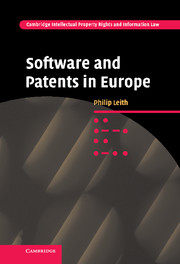Book contents
- Frontmatter
- Contents
- List of figures
- Introduction
- 1 Software as machine
- 2 Software as software
- 3 Policy arguments
- 4 Software patent examination
- 5 Holding the line: algorithms, business methods and other computing ogres
- 6 The third way: between patent and copyright?
- 7 Conclusion: dealing with and harmonising ‘radical’ technologies
- Index
- Cambridge Intellectual Property and Information Law
Introduction
Published online by Cambridge University Press: 22 July 2009
- Frontmatter
- Contents
- List of figures
- Introduction
- 1 Software as machine
- 2 Software as software
- 3 Policy arguments
- 4 Software patent examination
- 5 Holding the line: algorithms, business methods and other computing ogres
- 6 The third way: between patent and copyright?
- 7 Conclusion: dealing with and harmonising ‘radical’ technologies
- Index
- Cambridge Intellectual Property and Information Law
Summary
This text follows on from a number of insightful works in the Cambridge Studies in Intellectual Property Rights series, and I have set my goals to achieve as useful a work as have my predecessors – only the reader will know how close to that goal I have managed to get. However, there is a significant difference between this work on intellectual property and the others in the series, in that those others were much more firmly located in substantive and comparative law issues. This text differs somewhat and the difference can be found in the dual nature of my academic career – first as a computer scientist and then as an academic lawyer, but always with a highly sociological bent – and is directed at trying to match the new and radical technology of computing with the patent system, rather than provide an overview of substantive and comparative law: there are a number of other texts which already provide a legal overview very effectively. If there is novelty in this project, it is in the attempt to move the frame of reference so that the patenting of software ‘as such’ is seen as a respectable and valid goal, but is also seen as a project in which there is much to do.
My aim has also been to encourage computer scientists to engage with patent law, rather than – as many I suspect would prefer – to have lawyers just leave them alone.
- Type
- Chapter
- Information
- Software and Patents in Europe , pp. 1 - 5Publisher: Cambridge University PressPrint publication year: 2007



